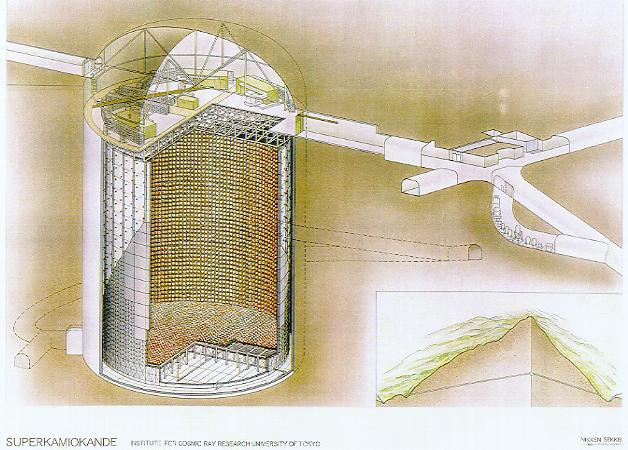

Large volume water detectors were invented to discover proton decay, but so far have only set limits (well in excess of the first predictions of the SU(5) Grand Unified Theory). As Super-K is 6-10 times larger than the previous generation of detectors, it can reach a proton lifetime of 10**34 years, probing predictions of modern Grand Unified Theories. Among the possible decay modes are very interesting signatures, such as p -> neutrino K+, which would provide evidence for mediation by the supersymmetric particles.
The background for proton decay are the interactions of 1 GeV neutrinos produced by cosmic ray showers in the upper atmosphere. As observed in the prior generation of water Cherenkov detectors, these atmospheric neutrinos, seemed to have puzzling behavior compared to theoretical expectation. In 1998, Super-K resolved this puzzle as being most likely due to neutrino flavor oscillation. This effect implies that the neutrinos have a small but finite mass. Super-K continues to collect 2500 contained neutrino interactions and 400 neutrino induced upward-going muons per year with which to study this new physics.
We are also using the Super-K detector in the KEK-to-Kamioka (K2K) long baseline experiment. Here we use a controlled beam muon neutrinos through the Earth, from the KEK accelerator laboratory, to the Super-K detector 250 kilometers distant. This experiment will directly test the neutrino oscillation result observed with atmospheric neutrinos.
Another hint for massive neutrinos is found in the apparent deficit of solar neutrinos, as recorded by several experiments of diverse technique. Super-K records about 4000 solar neutrino events per year, approximately 50% of the number expected by the Standard Solar Model. The rate of these low energy neutrinos is constantly monitored, to be on the lookout for a sudden burst of events from a distant, but dying sun. The Super-K detector would record 4,000 supernova neutrino interactions from a supernova in the center of our galaxy.